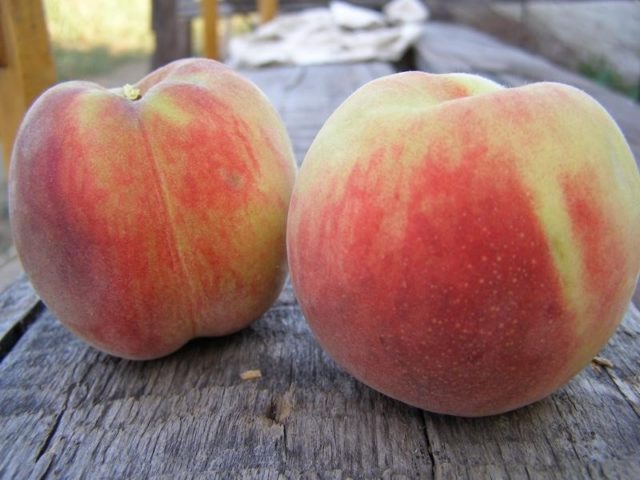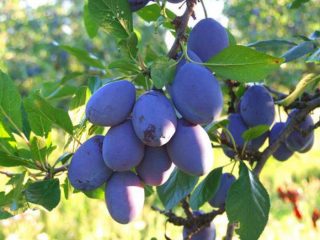Content
The Greensboro peach is a dessert variety that has been known for over a hundred years. Its delicate, large fruits are among the first to ripen in the southern regions with a hot climate, but they can ripen much further north. Peaches have long ceased to be exotic in the gardens of the middle zone. Proper care allows Greensboro to endure cold winters and consistently bear fruit both on the Black Sea coast and in the Moscow region.
History of variety selection
The Greensboro peach was developed in the late 19th century by open pollination from a Connet seedling. The homeland of this early-ripening and frost-resistant fruit is the USA. In 1947, the variety was zoned in the North Caucasus, the peach performed well in the Crimea, and spread widely in Central Asia and the Black Sea region.
Description of the Greensboro peach variety
The peach tree of the Greensboro variety, without enhanced shaping, grows tall with a spreading crown. Annual growth is average.Shoots with short internodes, smooth, take on a dark crimson hue in the light.
Peach leaves are medium long (up to 15 cm), folded in the shape of a boat in the center, with tips curved down. The upper side of the plate is dark green, the lower side is light gray. Petiole up to 1 cm. The edges have rounded teeth.
Fruit buds are large, ovoid, arranged in groups. The variety blooms profusely and amicably. The inflorescences of the Greensboro variety are pink-shaped. The petals are large, bright pink, round in shape.
Greensboro Peach Fruit Description:
- large size: more than 55 mm in diameter;
- oval in shape with a flattened, depressed apex;
- the average fruit weight ranges from 100 to 120 g;
- the pulp is fibrous, juicy, creamy with a green tint;
- the surface of the fruit is rigidly pubescent, rough;
- the skin is green with a slight burgundy blush;
- the bone is small, difficult to separate, prone to cracking.
With medium sugar content, Greensboro fruits have a balanced sweet and sour taste and a strong peach aroma.
The variety has been zoned and recommended for cultivation in the south of the country. But correct agricultural technology allows you to get excellent harvests in the middle zone, areas with moderate winters and warm, humid summers.
Characteristics of the variety
The Greensboro peach, according to the description of the All-Russian Breeding Institute, is a table fruit. An early-ripening, high-yielding variety that combines winter hardiness and drought resistance, which makes it possible to significantly expand its growing areas.
Drought resistance, frost resistance
The culture can withstand winters with temperatures below – 22 °C. Greensboro peach, even in the Moscow region, according to reviews, shows excellent survival rate.There have been cases of complete restoration of the plant after freezing and death of the above-ground part (at – 35 °C) to the level of snow cover.
The drought resistance of the variety is relative. The tree does not die from short-term drought, but the yield suffers, and the branches tend to become bare, which is why they winter poorly.
Does the variety need pollinators?
The Greensboro variety is self-fertile, trees can be planted in uniform plantings. The presence of other peaches in the garden for cross-pollination has a positive effect on the yield.
Grafted onto almonds, apricots, and cherry plums, Greensboro is grown on difficult soils unsuitable for self-rooted seedlings.
Productivity and fruiting
The Greensboro peach begins to bear fruit quickly: within 2–3 years. By the age of 10 years, trees gain full strength. The maximum recorded yield from one adult peach is 67 kg.
The variety is early in maturity. In the south, Greensboro peaches ripen in July, in black soil regions - by early August.
The taste qualities of the variety are rated by experts at 4.8 points out of 5. The dry matter content in the fruit reaches 12%, sugars - about 9%, acids - 0.4%, vitamin C - 6 mg per 100 g of pulp.
Area of application of fruits
Greensboro does not keep well. When pressed, the tender flesh becomes deformed and darkens. Therefore, the variety is not intended for transportation over long distances and long-term storage. If transportation is necessary, the fruits are picked at technical ripeness: approximately 3–4 days before full ripening.Peaches are packed in boxes, covered with soft, hygroscopic materials.
Resistance to diseases and pests
Greensboro is resistant to the main enemy of peach orchards, cluster blight, as well as powdery mildew. In the absence of proper care and prevention, it is prone to leaf curl.
Advantages and disadvantages of the variety
Over centuries of cultivation, the Greensboro variety has received undoubted recognition among gardeners for the following qualities:
- Early harvest.
- Frost resistance.
- Aroma and taste.
- Immunity to major diseases.
The disadvantages include:
- unequal fruit size: from 70 to 120 g on one tree;
- the need for urgent use due to rapid loss of presentation;
- limited zoning and the need for shelter for the winter in the central regions.
The negative aspects of the Greensboro peach, according to reviews from novice gardeners, are sometimes indicated by a tendency to leaf curl, but this deficiency can be easily corrected with appropriate care.
Rules for planting peach
A seedling of a well-selected variety appropriate to the climate must be properly rooted. The further growth, development, and fruiting of the Greensboro peach largely depends on this procedure. Timing plays an important role in planting.
Recommended timing
For the tender, heat-loving Greensboro peach, the following planting dates are recommended in different regions:
- In the south - in autumn (September or early October). When planting in spring, young plants suffer from heat and sunburn.
- In the middle zone - in autumn or spring, depending on the weather. The main criterion for planting is soil warmed to +15 °C.
- Closer to the north - only in the spring, when the soil and air warm up to comfortable temperatures.
In regions with cold winters and a lack of snow, Greensboro peaches are covered for the winter.
Choosing a suitable location
To plant a heat-loving variety, choose a sunny place protected from the winds, preferably without stagnant water. The best choice would be a southern slope.
The Greensboro variety grows on different types of soil, but does not tolerate acidic or saline soils. Heavy soils can be enriched with humus, mature compost with complex fertilizers. Add a little humus or mineral fertilizers to light soil.
Selection and preparation of planting material
It is advisable to purchase peach seedlings from special nurseries. This way, purchased trees will be guaranteed to correspond to the declared varietal qualities.
Signs of a good Greensboro seedling:
- height – from 1 to 1.5 m;
- age – up to 2 years;
- trunk girth about 2 cm;
- smooth bark without stains or damage;
- healthy, moist roots, without signs of pests.
For spring planting, Greensboro variety material is shortened to 80 cm, side shoots are cut off by a third. At night, place the root system in a solution with a growth stimulator (for example, Kornevin). In the morning the seedling is ready.
Autumn planting in Greensboro involves shortening the roots; it is advisable not to prune the trunk and branches until spring. On varietal greens with leaves, they are torn off before planting. Until the peach roots begin to fully function, the load should be reduced as much as possible.
Landing algorithm
The Greensboro peach planting site is prepared in advance. The hole is dug six months before the estimated date of work. A 40x40 cm recess is first prepared. The final size will depend on the root system of the seedling.
When the crown is freely formed, there should not be less than 3 m between plants.Peach does not tolerate thickening. Row spacing is kept from 4 to 5 m wide. Closer planting of Greensboro is only permissible with heavy pruning and shaping.
Planting a peach step by step:
- A support (stake, pole) is installed in the center of the planting hole.
- The bottom is covered with drainage (crushed stone, sand) at least 10 cm thick.
- A mound of fertile substrate is built around the support.
- The seedling is placed in the center of the hole so that the support shades the young plant from the daytime sun.
- The peach roots are carefully distributed over a mound of earth, sprinkled with a small layer of soil and lightly squeezed.
- Water the plant with a bucket of cold water and wait until the moisture is completely absorbed.
- At this stage, you can fill the hole completely with soil.
The scion neck is left 3 cm above ground level if the Greensboro peach is to be grown in tree form. In the bush version, the grafting site is buried in the ground.
A shaft of earth is formed along the perimeter of the seat. Pour 2 buckets of water under each peach. It is advisable to immediately mulch the soil, but do not lay the moisture-saving layer close to the trunk.
Peach aftercare
If planted in the spring, the Greensboro peach will swell with buds and appear leaves within 30 days.
Pruning is the most important peach care technique. Fruiting and even successful wintering of the seedling depend on the formation of the crown and regulation of the load. Standard techniques for pruning peaches of any variety are shown in the photo.
The Greensboro variety is distinguished by a cluster of fruit buds, mainly in the lower part of the growth. The branches of such varieties are shortened more than with a single arrangement of fruits on the shoot.
The goal of all care activities is to increase the winter hardiness of seedlings. This principle is especially important to observe when growing Greensboro peach in the Moscow region and other central regions. Winters in the middle zone are not characterized by critical frosts, but thaws are frequent, which has a bad effect on fruit buds and annual growth.
Greensboro peach care tips:
- When applying fertilizers in summer, preference is given to potassium compounds: potassium sulfate or ash. Nitrogen fertilizing (even organic) has a bad effect on preparing the variety for wintering.
- Greensboro peach fruits best with regular watering. If there is insufficient rain, the tree trunks should be deeply moistened once every 10 days. After harvesting, it is advisable to stop watering: this will reduce the growth of branches, but will increase the plant's resistance to frost.
- It is useful to mulch the peach tree trunk with a thick layer (at least 10 cm) of organic matter, for example, weeded weed. This protects the roots from frost in winter and ensures constant soil moisture in summer.
Normalizing the crop load allows the Greensboro variety to withstand cold weather more easily. In the spring, when pruning, it is worth removing the weakest ovaries or thinning them out if they are too abundant. Peaches, overloaded with fruits, are a delight during the season, but often freeze in winter.
Diseases and pests, methods of control and prevention
The resistance of the Greensboro variety to most diseases characteristic of peach allows for fewer preventive treatments with chemicals.But one of the viruses requires special attention.
The disease manifests itself as leaf curl and requires preventive spraying:
- in autumn – 3% Bordeaux mixture;
- in the spring – 1% solution of the same product;
- when infected – with the drug “Topaz”, diluted according to the instructions.
Garden crops with sweet fruits are often affected by aphids, codling moths, scale insects and striped moths. To control peach pests, Karbofos, Zolon, Atellik or other specialized insecticides are used.
Conclusion
The Greensboro peach is an exceptionally delicate and short-lived fruit. But its excellent taste, early harvest and winter hardiness of trees make the variety popular both in the south and in temperate zones.














